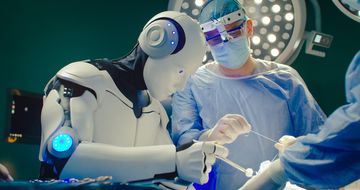Would you go under the knife if a robot was the one holding it? Or would you say, “No way, I need a human touch”? You might have to decide soon because a robot that can imitate skilled human surgeons is already here.Recently, researchers at Johns Hopkins University demonstrated that a da Vinci Surgical System robot, trained by watching videos of experienced doctors, could perform surgical procedures with the same accuracy as surgeons. Currently, the da Vinci’s robotic arms are controlled by surgeons.This breakthrough in imitation learning―wherein the robot learns by mimicking instead of being programmed to do tasks―is revolutionising robotic surgery, bringing it closer to true autonomy.The researchers' findings were recently shown at the Conference on Robot Learning in Munich, a top event for robotics and machine learning. Axel Krieger, an assistant professor at JHU's Department of Mechanical Engineering, and the senior author of the research, said they fed their imitation learning model―which drives the robot―with video input and it began to predict the accurate movements required for surgery.The model taught the robotic system how to perform three essential tasks in surgery: needle manipulation, tissue lifting, and suturing. The model combined imitation learning with the same machine learning architecture that powers ChatGPT. However, unlike ChatGPT, which processes words, this imitation learning model “speaks” in kinematics―a mathematical language that translates robotic movements into angles.Researchers utilised hundreds of videos recorded from wrist-mounted cameras on da Vinci robots during surgeries. These recordings, captured by surgeons worldwide, are generally used for post-operative review. With nearly 7,000 da Vinci robots in use globally and over 50,000 trained surgeons, this system has created an extensive archive for robotic imitation learning.
While the da Vinci system has been widely adopted, questions about its precision have remained. The Johns Hopkins team addressed this by training the model to execute “relative movements rather than absolute actions”, which are more prone to inaccuracies. This means allowing more space for the model to rely on its own learning and prediction skills. This method allowed them to make effective use of imperfect data, significantly improving the system's precision.The researchers suggest that this model could be used to quickly train robots for a variety of surgical procedures, advancing the goal of autonomous surgery, reducing medical errors, and achieving greater surgical accuracy.


